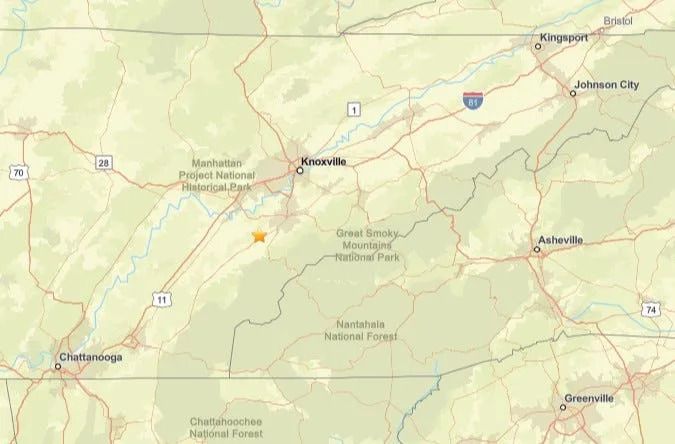A 2.6-magnitude earthquake shakes Knoxville, East Tennessee. Was it an aftershock? What to know
Another 2.6-magnitude earthquake rattled Tennessee on July 9 around 8:52 p.m., according to the U.S. Geological Survey - but you might not even have noticed.
The earthquake happened in Greenback, Tennessee, near the site of the 4.1-magnitude earthquake that was felt across Tennessee and nearby states on May 10.
The July 9 earthquake was relatively shallow, occurring about 16.5 miles below the surface.
The universal magnitude scale shows that earthquakes as minor as 2.5 can be felt in a community and could cause minor damage. Typically, building damage starts at 5.5 magnitude, according toearthquake experts at Michigan Tech University.
An estimated 500,000 earthquakes of 2.5 to 5.4 magnitude happen each year.
 A 2.6-magnitude earthquake rattled Greenback, Tennessee, on July 9, 2025.
A 2.6-magnitude earthquake rattled Greenback, Tennessee, on July 9, 2025.It's unclear if the two recent Tennessee earthquakes are connected, according to USGS Scientist Jessica Turner. The 2.6-magnitude earthquake may have been an aftershock of the May geological event; however, it occurred a bit northwest of the larger earthquake. Typically, aftershocks happen directly on top of the original earthquake's location.
Greenback, Tennessee, is about 30 miles southwest of Knoxville and 52 miles west of Gatlinburg.
East Tennessee earthquakes: Local quakes shows our fault lines. Experts say a far bigger one is possible
Are earthquakes common in Tennessee?
Earthquakes are fairly common in East Tennessee. Since the beginning of 2025, there have been 26 earthquakes in the region, according to Turner. Of those, only two have been above a magnitude 2.5: The May 10 earthquake and the July 9 event.
There were 177 earthquakes in Tennessee in 2024,according to USGS data. Ten of those were 2.5 magnitude or higher.
Why does Tennessee have earthquakes?
Minor earthquakes are common in the region due to the East Tennessee Seismic Zone, which extends across Tennessee, northwestern Georgia and into northeastern Alabama. The region is also within close proximity to the New Madrid Seismic Zone in West Tennessee.
Both seismic zones remain active, according to USGS.
Some fault systems, like San Andreas in California, have been well-studied and can help determine what specific fault caused an earthquake. But that’s not the case in East Tennessee.
“(The East Tennessee Seismic Zone is) a seismic zone we know the least about … and yet it's one of the largest ones in the Eastern U.S.,” U.S. Geological Survey geophysicist Thomas Pratt told Knox News last year. “So, it's a concern because it's long enough that it could have a pretty good size earthquake on it if the whole thing ruptures.”
Earthquakes in East Tennessee often occur so far underground (as far as 20 miles deep in recent cases) that it's extremely difficult to study the fault system and determine patterns. Some of the recorded quakes don’t reach the surface.
“The best guide to earthquake hazards in (this specific) seismic zone is the earthquakes themselves,” USGS stated in asummary of the 2018 Decatur tremor.
Pratt also noted that faults tend to be in valleys where rocks erode more easily. But when the Tennessee Valley Authorityintentionally flooded parts of the valleyin the early 20thcentury, that made it difficult to study those areas.
“So it could be that there's evidence for earthquakes down in some of those valleys, but they were flooded in the 1930s and '40s and so we will never know,” Pratt said.
Earthquakes in the Eastern U.S. can be felt at greater distances than those that occur in the west, USGS states. The Decatur quake was felt over a 310-mile span.
What have been the strongest earthquakes in East Tennessee?
These are the 10 strongest earthquakes to rattle East Tennessee since 1900, according to USGS data.
4.7 magnitude – Alcoa (1973)
4.5 magnitude – Greenville (1928)
4.4 magnitude – Decatur (2018)
4.2 magnitude – Vonore (1987)
4.1 magnitude – New Tazewell (1956)
4.1 magnitude – Luttrell (1913)
4.1 magnitude – Greenback (2025)
3.8 magnitude – Tazewell (1997)
3.8 magnitude – Fincastle (2020)
3.7 magnitude – Ducktown (1979)
How do earthquakes happen?
Earthquakes typically happen when blocks of rock shift in the Earth's crust, when underground rock suddenly breaks and there is rapid motion along a fault, according to Michigan Tech research.The burst of energy can cause the ground to shake, which we recognize as an earthquake.
Earthquakes in East Tennessee occur along fault lines like the New Madrid Seismic Zone and the East Tennessee Seismic Zone, or fractures between blocks of rock that allow the blocks to move relative to one another.
Is it possible to prepare for an earthquake?
Unlike tornadoes or hurricanes, scientists can't predict earthquakes. USGS scientists don't know where or when an earthquake might happen; they can only estimate the probability of such geological events.
However, that doesn't mean you can't prepare for the eventuality of an earthquake.
Before an earthquake happens, make an emergency plan and secure heavy items in your home and objects that hang on the wall, according to ready.gov. Store any heavy or breakable objects on low shelves.
When an earthquake happens, it's important to drop to the ground, grab onto a sturdy object and cover your head, according to ready.gov. If you're outside when an earthquake begins to rumble, get to an open area free of buildings, trees, streetlights, and power lines.
Allison Kiehl reports on trending and breaking news for the Tennessee Connect team. Email: [email protected]
This article originally appeared on Knoxville News Sentinel: 2.6-magnitude earthquake rattles East Tennessee. Is it an aftershock?














